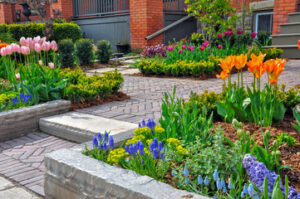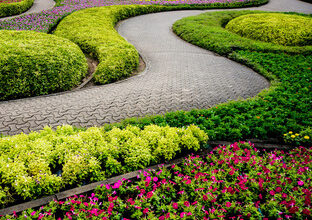Landscaping is a creative process that combines the use of living and nonliving horticultural elements to improve the visual appeal of a home’s exterior. It also consists of the structure of outdoor areas such as patios, walkways and retaining walls.
When starting your landscape plan, be sure to evaluate the condition of existing plants and structures. Make notes of things that work well and those that need improvement. Contact Landscaping Greensboro NC for professional help.
Landscaping involves creating a cohesive and visually appealing outdoor space that adds value to your home or business. A well-designed landscape can also improve air quality, reduce noise, and provide a place for people to relax or exercise. There are many different styles of landscaping, and the right choice will depend on your personal preferences and the needs of your property.
Landscape design is comprised of two main components: hardscaping and softscaping. Hardscaping includes elements like patios, walkways, retaining walls, and water features, while softscaping refers to the living elements of your landscape, such as plants, trees, flowers, and grass. Softscaping is an important aspect of your landscape, because it provides color and texture, as well as contributes to the overall aesthetic of your property.
Using color in your landscaping is an effective way to attract attention and set you apart from the competition. Use vibrant hues to showcase your creativity and uniqueness, but make sure the colors you choose complement the surrounding environment. You can also use landscape color to accentuate certain parts of your property, such as the entrance to your business or a specific flower bed. Some landscapers also incorporate wellness amenities, such as a jogging path or a community garden, into their designs to promote healthy lifestyles and boost morale among employees.
Form
The way landscape features look in three dimensions is referred to as form. Form includes the shape of a plant or feature as well as its relationship to other plants and the landscape overall.
Form is a big part of the design that helps give a landscape its character and feel. It can evoke emotions, make us happy or sad, and even remind us of things in our lives. For example, the sheared boxwoods and trimmed hedges on a property may add a sense of formality to a garden while the more natural Rhododendron shrubs in a woodland setting can give a more casual, woodsy feeling.
Lines are a very important element in the framework of a landscape. They can be straight, curved, horizontal or diagonal and are found in both hardscape materials like walkways and paths and softscape materials such as hedges and flower beds. Straight lines create a formal character and can guide the eye to a focal point or highlight a structure such as an outdoor fireplace or retaining wall. Curved lines, on the other hand, create a more informal and natural feel and can be used to connect spaces in the landscape or to add visual interest by creating curves in pathways or garden beds.
Besides lines, form also involves the shapes of landscape features and how they relate to each other. Form is a very important aspect of the aesthetic of a landscape and should complement the style of the home and the surrounding architecture. Landscape forms are categorized as rectilinear, angular or organic and can be achieved through the use of the different shapes of the house, walkways and driveways, hardscape materials and plants.
The final factor of form is scale which refers to the size of landscape elements in relation to each other and to the overall space. Scale is important in ensuring the harmony of a landscape, and it can be achieved by varying the sizes of planting beds, trees and individual plants within the garden or yard. This helps keep the garden from looking cluttered and makes the different parts of the garden look balanced and unified.
Texture
The surface quality of plants and their related hardscape elements is referred to as texture. This includes how rough or smooth they look and the contrast that can be achieved between these qualities. Like color and form, the use of texture helps provide interest and contrast to a landscape.
Generally, plant textures can be categorized as fine, medium or coarse. These can be determined by the size of a plant’s leaves and flowers, as well as its branching pattern. The shape of a leaf or stem may also contribute to its perceived texture.
Contrasting textures within a landscape produces eye-catching combinations and prevents monotony. The trick is to ensure that each texture does not overpower the others. To achieve this, a good rule of thumb is to include more plants with fine textures in the landscape than those with coarse textures.
In addition to providing contrasting appearances, textures can also be used to create a sense of depth and movement in a garden. A technique known as layering is a great way to add depth and dimension to a landscape by using plants with varying textures. Planting fine-textured plants along the perimeter and then using medium-textured plants to fill in the middle of a garden is one way to achieve this effect.
Another way to achieve this is by using bold, coarse-textured plants in the front of a garden. This draws and holds the eye, which is especially useful in small gardens where it can help make them feel larger.
Texture can be further manipulated by planting trees and shrubs with different foliage shapes. For example, rounded foliage such as boxwood shrubs and allium flowers fall into the fine category, while broad-leafed plants such as Stachys byzantina and yellow French marigolds have a medium texture.
It is important to consider the texture of a landscape throughout the seasons, as plant textures can change with the weather. For example, the bark and stems of deciduous plants become dominant textures in winter when their leaves have fallen. Keeping these seasonal changes in mind will help to create an engaging, year-round garden.
Lines
Lines define movement and direction throughout a landscape, establishing a visual rhythm that draws the eye through the composition. Whether a natural or man-made element, they can influence the way we perceive a landscape and what emotional response it evokes in us. Lines can be horizontal, vertical, diagonal or curved, and they can also imply or create a sense of distance in the landscape.
When used intentionally, lines can enhance a property line landscaping project and draw the eye to important focal points. For example, a straight line might guide the eye from an entryway to a fire pit or water feature. Conversely, a walkway that meanders might introduce a sense of mystery and reveal hidden views along the way.
While color tends to be the most prominent (and often over-used) design element, a strong sense of line is also essential to the overall impact of a landscape. This can be achieved by combining different textures, heights and colors to create contrast and balance.
Form is the three-dimensional configuration of plants and hardscape features that shape the landscape. Skillfully blending diverse forms creates a cohesive environment that is both beautiful and functional.
Lines are the most important component of a landscape and define movement, separating spaces and drawing the eye through the composition. Whether they are a straight or a curved line, they can create different emotional responses. Straight lines tend to be structural and forceful, while curved lines feel more natural and relaxed. They can also add a sense of movement or flow to a landscape.
Property line landscaping can be a challenge. It is important to have a clear idea of your property lines so that you do not end up having to pay for your neighbors landscaping. This is why it is a good idea to contact a professional landscape surveyor before you begin your project.
There are several ways to define your property line including a wood fence, PVC vinyl fence or a traditional stone wall. Each has its own unique benefits and looks and you should consider what type of property line landscaping is right for your home.

